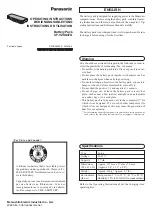
Operating Instructions
3
01806E
ATTENTION: Utiliser pour chargeur
uniquement les accumulateurs au plomb à
electrolyte liquide. D'autres types d'accumu-
lateurs pourraient éclater et causer des
blessures ou domages.
DANGER: RISK OF ELECTRIC SHOCK! DO
NOT TOUCH UNINSULATED PORTIONS OF THE
OUTPUT CONNECTOR OR UNINSULATED
BATTERY TERMINALS.
DANGER: Risque de chocks électriques. Ne
pas toucher les parties non isolées du
connecteur de sorti ou les bornes non isolées de
l'accumulateur.
1.
With the charger DC output cord disconnected
from the batteries, connect the input plug to a
properly grounded 120 volt, 60 Hertz outlet with
the same number and size pins as the plug.
WARNING: TO REDUCE THE RISK OF AN
ELECTRIC SHOCK, CONNECT ONLY TO A
PROPERLY GROUNDED SINGLE-PHASE (3-
WIRE) OUTLET. REFER TO GROUNDING
INSTRUCTIONS.
2.
Connect the DC output plug to the battery
receptacle by grasping the plug body or handle
and pushing the plug straight into the receptacle.
The charger will turn on with an audible "click"
after a short delay if all circuits and battery
voltage test good. The transformer will "hum"
and the ammeter will indicate initial charge rate.
WARNING: DO NOT DISCONNECT THE DC
OUTPUT CORD FROM THE BATTERY
RECEPTACLE WHEN THE CHARGER IS ON.
THE RESULTING ARCING AND BURNING WILL
DAMAGE THE CONDUCTORS AND COULD
CAUSE THE BATTERIES TO EXPLODE.
DISCONNECT THE AC POWER SUPPLY CORD
TO TURN THE CHARGER "OFF" BEFORE
DISCONNECTING THE OUTPUT PLUG.
3.
Monitor the ammeter for the initial charge rate.
The initial charge rate will vary from 16 to 25
amperes depending upon the condition of the
batteries and how much the batteries have been
discharged. Slight variations in the initial charge
rate may also result from AC input line voltages
which are higher or lower than nominal. Higher
line voltages increase the initial charge rate
while lower line voltages reduce the charge rate.
If the batteries are heavily discharged and the
AC input line voltage is higher than nominal, the
initial charge rate may exceed 25 amperes.
Under normal conditions, the charge rate will
taper to less than 25 amperes within 30 minutes.
If the ammeter still reads more than 25 amperes
after 30 minutes, turn the charger off by
disconnecting the power supply cord from its
outlet.
CAUTION: TO PREVENT BATTERY
DAMAGE, CHARGER OVERHEATING, AND
TRANSFORMER BURNOUT, DO NOT ALLOW
THE CHARGER TO OPERATE FOR MORE THAN
30 MINUTES WITH THE AMMETER READING IN
EXCESS OF 25 AMPS. THIS IS MISUSE AND
WILL CAUSE OVERHEATING AND TRANS-
FORMER BURNOUT.
4.
The charge rate will decrease to 4 to 9 amperes
for the last few hours of charge if all battery cells
test good.
During charge, the battery voltage increases
gradually causing the charge rate to decrease.
Good battery cells should each rise to
approximately 2.5 volts DC, causing the charge
rate to reduce to less than 9 amps. Each cell
accepts charge differently; normal charging with
the ammeter reading in the 4 to 9 amps area for
the last few hours of charge is important to
achieve equalization of all battery cells every
time the batteries are charged.
As batteries age, individual cells weaken
resulting in lower than normal finish charge
voltage. As the finish charge voltage decreases,
the finish charge rate increases and no longer
reduces into the 4 to 9 amps range on the
ammeter. The electronic timer still determines
when the batteries have reached their maximum
state of charge and turns the charger off. Even
though they are properly charged, older
batteries will gradually lose capacity, and should
be replaced when they will no longer perform as
required.
The charger turns off automatically when the
batteries reach full charge. The necessary
charge time is affected by numerous factors.
The major factors affecting the required charge
time are battery amp-hour capacity, depth of
discharge, battery temperature and if the battery
is new or broken in. The required charge time
varies with battery size and depth of discharge.
Under normal operating conditions, the
maximum necessary charger time is 10 to 12
hours.
This normal charge time is for batteries that
have been discharged to 80% of their rated
capacity. As much as 4 ADDITIONAL HOURS
may be required to properly charge batteries
under the following conditions:
a.
Heavily discharged batteries (more than
80% discharged).

























